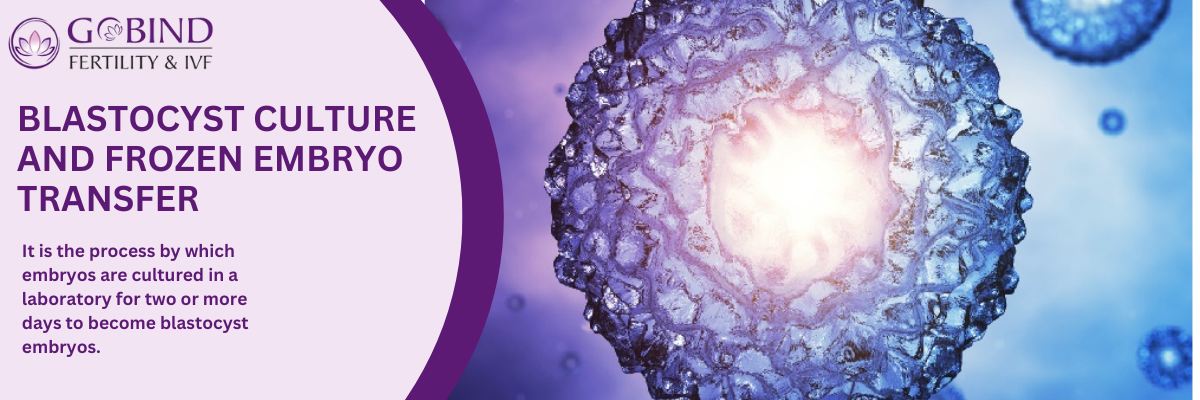

Blastocyst Culture and Frozen Embryo Transfer
Blastocyst culture is an IVF option that enables the embryos to be cultured for five to six days to the advanced blastocyst stage, which enhances selection for transfer.
FET or fresh embodiment transfer involves the donation of embryos that have been frozen and then transferred to the uterus of the woman at a convenient time from one IVF cycle.
Blastocyst Culture:
During the second or third day of fertilisation, when the embryos are in the cleavage stage (2–8), they are usually delivered to the uterus in a traditional IVF cycle.
- In blastocyst culture, embryos are grown and developed in a lab incubator for five days, or until they reach the blastocyst stage, which is when the embryos have more than 100 cells.
- The embryo has developed into an exterior layer of cells (which will become the placenta) and an interior cell mass (which will become the fetus) at the blastocyst stage.
- Blastocyst culture makes it possible to more carefully choose the best embryos for transfer because only the healthiest embryos can progress to this stage. Increased implantation rates and a decreased likelihood of multiple gestations (twins or triplets) are potential benefits.
Frozen Embryo Transfer (FET):
- Instead of transplanting every embryo at once during a new IVF cycle, certain embryos may be cryopreserved (frozen) for possible use at a later time.
- In a different cycle from the initial egg retrieval, frozen embryos are thawed and then placed into the woman's uterus through FET.
Since ovarian stimulation is not required during FET cycles, medication requirements are typically lower. Hormones are released during a woman's cycle to prepare the lining of her uterus for the implantation of an embryo.
- When there is a risk of ovarian hyperstimulation, when the uterine lining is thin, or when genetic testing of the embryos is wanted before transfer, FET may be advised.
The success rates of frozen embryo transfer is better than fresh embryo transfer in antagonist protocol cycle.
-It is possible to freeze embryos at different stages (blastocyst or cleavage), although blastocyst freezing is more frequently done.
Advantages of blastocyst culture and FET include:
- Improved embryo selection and higher implantation potential
- Reduced risk of multiple gestations
- Ability to batch multiple IVF cycles by freezing embryos
- Flexibility in the timing of embryo transfer
However, these techniques require advanced laboratory expertise and equipment, and not all embryos may survive the freezing and thawing process. The decision to use these methods is made by the fertility specialist based on individual patient factors and circumstances.
Our state-of-the-art IVF laboratory at GOBIND Fertility & IVF is set up to nurture embryos up to the blastocyst stage, which is the last step of preimplantation embryo development before implantation. Superior selection of high-quality embryos most likely to result in a healthy pregnancy is made possible by blastocyst culture.
Our lab incubators closely monitor the resultant embryos once they are fertilised using either conventional IVF or ICSI. The blastocyst stage is open to those who develop at their best during a period of five to six days. Before being chosen for cryopreservation (freezing) or fresh embryo transfer, these blastocysts are assessed for overall quality.
Using blastocysts that have been previously frozen from an IVF cycle, our facility also provides frozen embryo transfer (FET) cycles. FET frequently leads to higher implantation rates by enabling patients to transfer thawed embryos in a different cycle from fresh IVF stimulation.
Similar to a fresh embryo transfer, the FET procedure entails hormonally prepping the uterine lining before gently thawing and transferring one or more frozen blastocysts via a catheter.
When compared to an IVF round, freezing extra blastocysts and using FET minimise expenses and drugs while offering prospects for future family development.
Blastocyst Culture & FET FAQ:
Q: What are the benefits of blastocyst culture?
A: It enables the selection of high-quality embryos most likely to implant successfully. It also synchronises the embryonic age with the uterine environment.
Q: Are there any risks with blastocyst culture?
A: For reaching till blastocyst more embryos are required. Our team provides guidance on the number of blastocysts to transfer.
Q: How are embryos frozen and frozen embryo transfers performed?
A: Blastocysts are frozen through an ultra-rapid freezing process called vitrification. For FET, frozen embryos are carefully thawed and transferred into the uterus.
Q: How successful are frozen embryo transfer cycles?
A: FET success rates are comparable to or sometimes higher than those of fresh IVF cycles, as the uterine lining is optimally prepared.

















